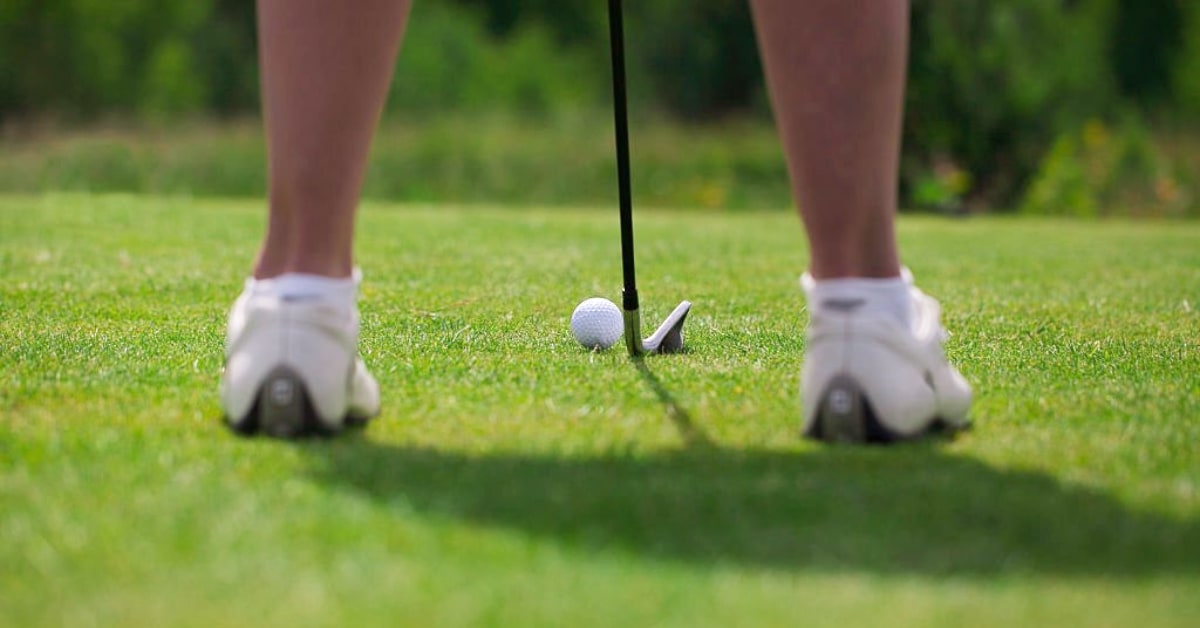The shank is one of the most frustrating and ugly shots in golf.
Quite simply, it’s also one of the hardest shots to recover from on the course.
There are a handful of reasons for shanking wedges — I’ll cover those in this article. Also, I’ll give you a step-by-step guide to help you prevent it.
So, let’s get straight into it!
What is a Shank in Golf?
First, let’s define what a shank is.
A shank, affectionately known as a “hosel rocket,” is a golf shot where the ball is struck off or near the club’s hosel. The result is a shot that goes straight right and often gets very little height. For you lefties, your version of the shank scoots out to the left. The shank is one of golf’s most cringe-worthy shots.
Check out an unfortunate demonstration from Justin Thomas below:
Why Am I Shanking My Wedges?
The most commonly asked question golfers ask after the old hosel rocket happens is why? In short, there are three main reasons causes for the shank:
- Poor setup and pre-swing fundamentals
- Poor swing path
- Poor rotation in the downswing
Before we dig into and detail these three primary reasons why shanks happen, let’s dispel a myth. Shanks DO NOT occur because of an open clubface — quite the opposite, as a closed face is the culprit.
Watch Butch Harmon’s Golf Digest video below as he explains this phenomenon:
Reason #1: Poor Setup & Pre-Swing Fundamentals
Like with many of the potential issues in the golf swing — poor setup and pre-swing fundamentals can be a huge contributor, not least with the shank.
P.G.A. is an old acronym I still use today in my teaching and coaching. This stands for Posture, Grip, and Alignment. If one or more of these primary principles are out of whack, you are setting yourself up for failure, even before you swing the club.
Consider the following:
P — Posture
Are you standing too close to the ball? If you’re frequently shanking wedges, this could be one of the most straightforward reasons for doing so.
If you’re crowding the ball, it gives you very little room for your hands to clear your body on the downswing — even if you are rotating your body well through impact.
With little room for the hands, you will have a very high chance of introducing the heel and hosel of the club into the ball at impact, resulting in a shank.
G — Grip
Your hands are your body’s only connection to the club. With that said, how you hold the club will influence how the clubface meets the ball at impact.
Here are three important things to check with your grip to help eliminate the chance of a shank due to poor grip mechanics:
- Clubface Alignment: Make sure the face of the club is square to your target line. Not open or closed in relation to the direction you’re aiming toward.
- Strive for a Neutral Grip: Go for a more neutral grip, with the “V’s” between your index finger and thumb pointing at your trail shoulder at address.
- Moderate Grip Pressure: Your grip should be strong enough that the club doesn’t twist at any point in the swing, but loose enough that you are not death gripping and creating unnecessary tension in your forearms.
Similarly, some players struggle with hitting their wedges off the toe. In both cases, focus on delivering a square clubface with a neutral and moderate grip.
A — Alignment
Many poor shots, including the shank, can be attributed to having poor alignment, both in terms of body alignment and the target alignment with the clubface.
Regarding body alignment, you want your toes, knees, hips, and shoulders to be parallel left of your target line (that’s parallel right for our lefty readers).
Getting any of those body lines out of whack, especially too open, can lead to path issues on the downswing. An outside-to-inside path can indeed cause a shank.
PRO TIP: Make sure your ball position doesn’t shift too far back in your stance, as this can limit your ability to square the face up at address. This exposes the hosel, and risks a shank.

Reason #2: Poor Swing Path
Importantly, the path you swing the club on can lead to your shanking woes.
Simply put, an excessively over-the-top or out-to-in path can cause a shank.
Many golfers know how an out-to-in path on the downswing can lead to problems, and that an inside-to-outside delivery of the club is ideal on the downswing.
But, despite that knowledge, most fail to understand one key thing: the backswing will often inform how you swing the club on the downswing.
Golfers will very often rip the club too far to the inside on the backswing, in an attempt to ensure that they return the club from the inside on the downswing.
In actual fact, this is counterproductive.
Going to the inside on the backswing often leads to an over-the-top or outside-to-inside downswing. That path on the downswing can often cause a shank.

Reason #3: Poor Rotation in the Downswing
The last thing golfers should consider in their quest to stop shanking is how they move their bodies in the downswing — specifically the body rotation.
In golf, the proper downswing sequence should look a little like this:
Pressure shift into lead foot → Hips start to unwind → Upper torso (chest and shoulders) stays over the ball and follows the hips in unwinding → While maintaining the wrist hinge, the hands follow next in line → The clubface is last in the parade, hopefully coming into the ball square with the hands leading.
It’s common for golfers not to follow this sequence correctly and often not rotate the lower and upper body sufficiently enough in the downswing.
This will usually result in what is called early extension.
In early extension, the hips, due to a lack of rotation, and the golfer losing their posture, will move toward the ball. This limits the space the hands have as they move into the ball. As a result, the club will steepen and very often introduce the heel and hosel of the clubhead into the ball.
Another common swing fault in the downswing is sliding. When a golfer slides, they move the lower body laterally towards the target. This gets the body too far out in front of the ball before impact. Getting the clubface squared up in time becomes a significant challenge when this happens.
Wedges — and lofted clubs in general — are particularly prone to the shank.
This is because the wedge swing is more upright than with longer clubs, putting you closer to the ball at setup. Ultimately, this raises the probability of a shank.

How to Stop Shanking Wedges
In the previous section, I covered the various reasons why a shank happens.
With those things in mind, you can use this checklist to help you shake those shanks the next time they creep into your game.
- Check your pre-swing fundamentals of P.G.A. (Posture, Grip, and Alignment).
- Work on your swing path. The best way to do this is to record your swing from down the line and face-on and give it a look… Better yet, set up a lesson with a PGA or LPGA Coach to help you dissect it.
- Work on your body movements and downswing sequence. Record your swing, check it, and contact your local golf professional for assistance.
One of the simplest drills to help you conquer the shanks is to put something, whether it be a headcover, range basket, tees, or anything really, just to the outside of the ball as you practice on the range.
Avoiding that obstacle as you approach the ball on your downswing will help you swing more from the inside and square up the face at impact.
Final Thoughts
Shanking your wedges can be scary, frustrating, humiliating, and many other things to those suffering from hitting them. This article should prove to be helpful for you as you navigate your way through this temporary issue.
Here are a few critical final thoughts to keep in mind:
The shank can often become something that goes well beyond a swing issue and can creep into your psyche. Ultimately, you need to stay patient and work at it with a positive mindset in order to combat it.
If you do indeed eliminate it, know that it could certainly come back at any point, but learn not to fear it. If you conquered it once, you can do it again!


